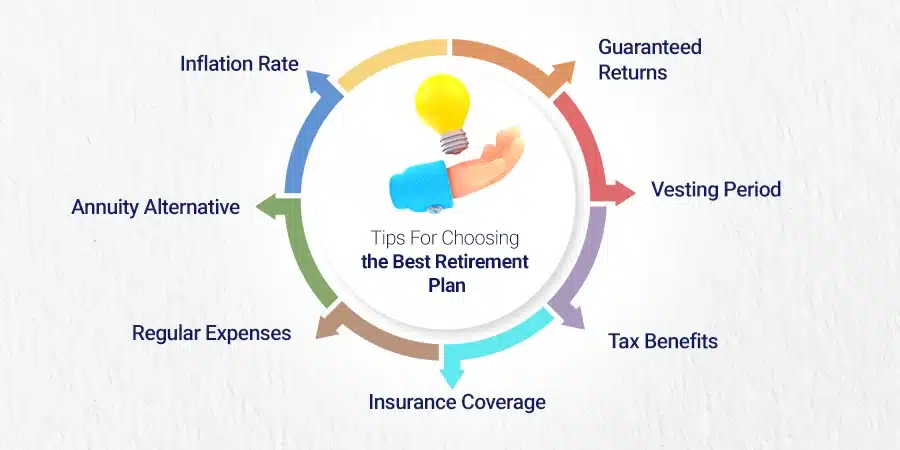Retirement may seem like a distant reality, but proper planning is the key to ensuring a comfortable and worry-free retired life.
Studies show that starting your retirement planning early allows you more opportunities to grow your savings over time.
This blog post will guide you through the first steps of retirement planning, from setting clear goals to choosing suitable investment plans. Let’s dive right in and pave the way for a secure future!

Key takeaways
●Start planning for retirement early to take advantage of compound interest and develop good savings habits.
●Determine your retirement savings goal and assess your current financial situation to prioritize your goals.
●Understand different types of retirement savings accounts, assess your risk tolerance and investment goals, and consider diversifying your investments.
●Prepare for future medical costs and factor in inflation when creating a comprehensive retirement plan.
What is the First Step in Retirement Planning
Retirement planning plays a key role in ensuring financial security during the golden years. It’s more than just about being free from work; it involves comprehensive planning to meet financial needs and achieve post-retirement lifestyle goals.
A well-crafted financial plan to retire helps maintain the same quality of life after re tiring, reducing reliance on Social Security alone.
Inadequate retirement savings can pose significant risks, including potential financial difficulties in the later stages of life. Properly planned retirement savings allow one to handle unexpected costs and emergencies without stress or debt.
With accurate analysis and foresight, you can optimize your investments while minimizing risk and tax implications.
Specifically tailored advice from a professional financial advisor including a tax advisor is instrumental in crafting an efficient personal investment strategy that aligns with your individual requirements and goals.
Remember, it’s not only what you save but how you save that defines your future comfort!

- Financial security
- Compound interest growth
- Goal-oriented approach
- Diversification
- Peace of mind
- Tax advantages
- Financial instability
- Missed compound interest
- Insufficient savings
- Limited investment growth
- Lack of clear goals
- Potential tax burden
When is the Right Time to Start Retirement Planning?
You might think there’s an exact retirement age to start planning for retirement. In reality, the best time is as early as your first paycheck.
Starting early has multiple benefits. It allows compound interest to work in your favor and helps you develop good savings habits. There are key moments throughout life when focusing on retirement becomes even more important.
For instance, whenever you switch careers or get a significant raise, it presents perfect opportunities to increase your retirement contributions.
And don’t stress if you’ve not yet started – remember fact three, it’s never too late! The choice of when to retire also plays into this planning process. It could be influenced by various personal factors like health status and job satisfaction levels along with financial readiness.
Social Security defines the full retirement age at 67 but starting claims can begin at 62 with reduced benefits and can be delayed till 70 for increased advantages as stated in fact one.
Though seemingly daunting, planning for the golden years doesn’t have to be complicated or overwhelming instead see it as an active process that flexes with your evolving lifestyle and financial situation over time.

First Steps in Retirement Planning
Determine your retirement goals and assess your current financial situation to prioritize your personal finance goals. Ready to take the first steps toward a secure retirement? Read on!

Determine Your Retirement Goals
Visualizing your dream retirement is the initial step to achieving it. It’s crucial to assess your current financial situation and define the lifestyle you envision during retirement. Think about what expenses might arise, such as travel or healthcare costs.
Next, set specific finance goals that will help you meet these expected expenses. This process of setting early retirement goals requires regular review and adjustments for better preparedness in attaining a secure post-work life.
Use online tools like the Personal Retirement Calculator to get a clearer picture of where you stand now and how much more you need to save for your golden years.
Figure Out How Much Money You'll Need to Retire
Determining how much money you’ll need to retire is a crucial step in your journey when you plan for your retirement. It involves assessing your current financial situation, estimating your future years until retirement expenses, and setting specific financial goals.
To calculate the amount needed for post-retirement, consider factors such as your current income, desired replacement percentage of annual pre-retirement income, and expected expenses during retirement.
Regularly reviewing and adjusting these estimates will help ensure that you have enough savings to maintain your desired retirement lifestyle throughout your retirement years.
Assess Your Current Financial Situation
To effectively plan for retirement, it is essential to assess your current financial situation. Take stock of your income, expenses, and any outstanding debts or financial obligations you may have.
Consider factors such as your salary, investments, savings accounts, and any other sources of income. By understanding where you stand financially right now, you can make informed decisions about how much you need to save for retirement and what steps you need to take to reach your goals.
Don’t forget to also review your monthly expenses and identify areas where you can potentially cut back or save more money. Taking a thorough look at your current financial situation is the first step toward creating a solid retirement plan that suits your needs.
Prioritize Your Financial Goals
To effectively plan for retirement, it’s crucial to prioritize your financial goals. This means determining what is most important to you and allocating your financial resources accordingly.
Start by considering your immediate needs, such as paying off high-interest debt or building an emergency fund. Once these goals are addressed, you can shift your focus towards long-term objectives like saving for retirement.
By prioritizing your financial goals, you can ensure that you’re making the most of your resources and working towards a secure future.
It’s also important to keep in mind that retirement savings need to last potentially into the 90s due to longer life expectancy. That’s why it’s essential to consider factors like rising costs and inflation when prioritizing your financial goals.
You can use this money to cover your daily expenses, such as groceries, fuel, electricity, and more.
You can also meet your post-retirement goals, such as traveling, pursuing a hobby, starting a new venture, and more.
Choosing the Best Retirement Plan
Understand different retirement accounts, assess your risk tolerance and investment goals, and consider the benefits of diversifying your investments.

Understanding Different Retirement Accounts
Various retirement savings accounts offer different benefits and features to help individuals save for their future. Some popular options include 401k, IRA, 403(b), SEP-IRA, HSA (Health Savings Account), Social Security, and brokerage accounts.
Individual retirement account has its own rules and requirements, so it’s important to understand how they work before making a decision. For example, a 401k is typically offered by employers and allows employees to contribute pre-tax dollars towards retirement savings.
On the other hand, an IRA is an individual retirement savings account that offers a tax advantage but has contribution limits. By understanding the different types of retirement savings accounts available, individuals can make informed choices about where to invest their money for a secure financial future.
Assessing Risk Tolerance vs. Investment Goals
Assessing your risk tolerance and investment goals is a crucial step in choosing the best plan during the time of your retirement. Determining how much risk you are comfortable with will help guide your investment decisions.
Consider factors such as your age, financial situation, and long-term goals to figure out what level of risk aligns with your comfort zone. Additionally, understanding your investment goals is essential for creating an investment portfolio that matches your desired outcomes.
Whether you’re aiming for growth, income, or a combination of both, aligning your investments with these objectives will help you work towards achieving them in retirement.
The Benefits of Diversifying Your Investments
Diversifying your investments is an important retirement strategy and planning. By spreading your money across different types of investments, such as stocks, bonds, and mutual funds, you can reduce the risk of losing all your savings if one investment performs poorly.
Diversification and asset allocation help to balance out the potential ups and downs of the market and can provide a more stable long-term return on investment. It also allows you to take advantage of different opportunities for growth in various sectors or asset classes.
Ultimately, diversifying your investments can help protect your savings and increase the likelihood of achieving your retirement goals.
Potential Risks and Challenges in Retirement Planning
Prepare for future medical costs. Factor in inflation. Deal with market volatility. Investing in a retirement plan comes with its own set of risks and challenges that need to be addressed.
Read on to learn more about these potential obstacles and how to navigate them successfully.
Preparing for Future Medical Costs
Preparing for future medical costs is an essential part of retirement planning. As we move toward our retirement age, our healthcare needs tend to increase, and it’s important to be financially prepared for any medical expenses that may arise.
One way to plan for these costs is by considering long-term care insurance or setting aside funds specifically designated for medical expenses in retirement. By factoring possible healthcare expenses into your overall budget and retirement savings plan, you can help ensure that you have the financial means to take care of your health as you enjoy your retirement years.
This proactive approach can provide peace of mind and help alleviate stress when it comes to managing potential medical costs later on in life.
Factoring Inflation into Your Retirement Plan
Factoring inflation into your retirement plan is crucial for ensuring that your savings can withstand the rising standard of living. With longer life expectancies, it’s important to understand that your retirement savings may need to last well into your 90s.
The average inflation rate in the US over the past century was 3.22%, so it’s essential to account for higher prices in the future. When creating a retirement budget, make sure to include housing costs, healthcare expenses, and day-to-day living expenses, all of which can be affected by inflation.
By factoring in inflation and planning accordingly, you can help protect your financial independence and ensure a comfortable retirement lifestyle.
Dealing with Market Volatility
Market volatility can pose challenges for those planning for retirement. It is important to be prepared for fluctuations in the stock market, as they can impact the value of investments and potentially affect retirement savings.
With bond yields currently at lower levels, it may be more difficult to earn a high return on fixed-income investments. Defined contribution plans, such as 401(k)s, are subject to market movements and have replaced defined benefit pensions that offered guaranteed retirement income.
Staying informed about market trends and working with a certified financial planner can help individuals navigate these challenges and make proactive decisions to protect their retirement savings.
Common Mistakes to Avoid in Retirement Planning
Avoid delaying your savings, not taking full advantage of your retirement savings account, and ignoring the tax deduction implications of retirement savings.

Delaying Savings
Delaying savings for retirement is a common mistake that can have serious consequences. Many people put off saving for their future, thinking they have plenty of time to catch up later.
However, the truth is that the longer you wait to start saving, the harder it becomes to build an adequate nest egg. Delaying savings means missing out on years of potential growth and compounding interest, making it much more difficult to reach your retirement goals.
Don’t fall into this trap – start saving for retirement as early as possible to ensure a secure financial future.
Not Taking Full Advantage of Retirement Accounts
Many people fail to realize the full potential of their retirement savings account, which can have a significant impact on their financial future. By not taking advantage of these accounts, individuals may miss out on a valuable tax advantage and the opportunity for their savings to grow over time.
There are various choices to consider when it comes to a retirement savings account, including rolling over to a new account, taking a distribution, or leaving the account where it is.
Each choice offers different investment options, fees, withdrawal options, required minimum distributions, and tax treatment.
It is essential to carefully assess these choices because they can be complex and have lasting effects on your retirement plans. Don’t let complacency limit your financial growth – make sure you’re maximizing the social security benefits of your retirement accounts.
Ignoring Tax Implications of Retirement Savings
Ignoring tax implications in retirement planning can have serious financial consequences. Taxes can significantly impact your retirement savings and income, so it’s crucial to understand how they will affect you.
By not considering tax implications, you may miss out on opportunities to maximize your savings and minimize your tax liability.
One common mistake to avoid is underestimating the amount needed for retirement.
Taxes can eat into your retirement funds more than anticipated if not properly accounted for. Additionally, overreliance on Social Security without understanding its taxation rules can result in a smaller income than expected during retirement.
Another potential pitfall is not diversifying investments strategically with taxes in mind. Failing to consider the tax implications of different investment vehicles could lead to unintended tax consequences when withdrawing funds from various accounts.
Catching Up on Retirement Savings
Increase your savings rate, cut expenses, and maximize employer contributions to catch up on retirement savings.
Making Use of Catch-Up Contributions
Individuals aged 50 or older have the opportunity to accelerate their retirement savings through catch-up contributions. Catch-up contributions are additional amounts that can be contributed to a retirement savings account, above and beyond the regular contribution limits.
This is a valuable tool for those who may have fallen behind in saving for retirement. The specific amount of catch-up contributions allowed varies depending on the type of retirement account, but it provides an excellent opportunity to make up for lost time.
By taking advantage of catch-up contributions, individuals can boost their retirement savings and potentially enjoy greater financial and social security in their golden years.
Downsizing Debt
Downsizing debt is an important step in catching up on retirement savings. By reducing or eliminating debt, individuals can free up more money to put toward their retirement goals.
This means paying off credit cards, car loans, and mortgages before entering retirement. It’s crucial to carefully consider the choices when downsizing debt, such as whether to take a distribution from retirement savings accounts or leave the funds where they are.
By prioritizing debt reduction, individuals can work towards entering retirement with less financial burden and more peace of mind.
What you what to know about Low-Risk Investments
What is low-risk investing? Why should one own low-risk investments? When should one buy low-risk investments? What is risk management?
Here’s what you need to Knows about Retirement Planning
How Much Should I Save for Retirement?
Determining how much you should save for retirement is a crucial step in your retirement planning journey. The retirement money you need to save depends on various factors such as your current income, desired lifestyle in retirement, and the percentage of pre-retirement income you want to replace.
While experts often recommend saving around $1 million for retirement, it’s important to consider individual circumstances and the cost of living in your area.
Additionally, with increasing life expectancy, it’s essential to ensure that your savings can last potentially into your 90s.
Starting early and regularly contributing to your retirement funds can help you build a substantial nest egg over time. Remember, creating a budget that includes dedicated savings for retirement is an important part of securing a financially comfortable future.

What Are the Benefits of Investing in Mutual Funds for Retirement?
Investing in mutual funds for retirement offers several retirement benefits. First, mutual funds provide diversification by allowing individuals to invest in a wide range of securities such as stocks and bonds and other investments to build their retirement nest egg.
This diversification helps reduce risk since the performance of one investment won’t have a significant impact on your entire retirement portfolio. Second, mutual funds are managed by professional fund managers who have expertise in selecting and managing retirement investments.
This means you can benefit from their knowledge and experience without having to make individual investment decisions yourself. Lastly, a mutual fund offers convenience and automatic contributions, making it easy for you to consistently save for retirement over time.
A retirement plan can help you continue your current lifestyle even after retirement.
How Does Income Tax Impact Retirement Planning?
Income tax plays a significant role in retirement planning as it affects the amount of money individuals have available for their savings. Different retirement accounts have different tax implications, with traditional IRAs offering tax-deferred contributions and withdrawals, meaning taxes are paid when the funds are withdrawn in retirement.
On the other hand, Roth IRAs provide tax-free withdrawals if certain conditions are met. It’s important to be mindful of the impact of income tax when making decisions about which retirement savings accounts to contribute to and how much to save.
Additionally, taking early withdrawals from retirement savings accounts may result in penalties and additional taxes. By employing strategies such as tax-efficient investing and tax diversification, individuals can minimize the impact of income tax on their retirement savings.
What Are the Different Tax Advantages Associated with Retirement Planning?
Retirement planning comes with numerous tax advantages. These benefits make the process of saving for retirement more manageable and rewarding.
Retirement Plan | Tax Advantage |
Traditional IRA | Contributions may be tax-deductible, allowing you to lower your current taxable income. Plus, earnings grow tax-deferred until you withdraw them in retirement. |
Roth IRA | Contributions are made with after-tax dollars, but qualified distributions in retirement are not subject to income tax. |
401(k) | These employer-sponsored retirement plans allow for pre-tax contributions, which can considerably reduce your taxable income. |
Health Savings Accounts (HSAs) | Contributions are made with pre-tax income, which reduces your taxable earnings. Additionally, withdrawals for qualified medical expenses are tax-free. |
Annuities | Annuities offer tax-deferred growth. This means you won’t pay taxes on your earnings until you start receiving payments in retirement, allowing your savings to grow more efficiently. |
These tax advantages are potential game-changers for your retirement planning, as they can significantly boost your savings.
Remember, every dollar saved on taxes is an additional dollar that can be invested toward your future.
Conclusion
In conclusion, the first steps of retirement planning are crucial in ensuring a financially secure future. By determining your retirement goals, assessing your financial situation, and choosing the best retirement plan for your needs, you can set yourself up for success.
Avoiding common mistakes and catching up on savings can further enhance your retirement readiness. Remember to regularly review and adjust your plan as needed to stay on track toward a comfortable retirement.
With careful planning and smart decision-making, you can enjoy a fulfilling life after work.
FAQs
The first steps of retirement planning include determining your desired full retirement age, estimating your future expenses and income, assessing your current savings and investments, and creating a budget to save for retirement.
To estimate your future expenses in retirement, you should consider factors such as housing costs, healthcare expenses, daily living expenses, travel plans, and any other lifestyle choices or goals you have for your post-retirement years.
It is recommended to start saving for retirement as early as possible. The earlier you start saving and investing, the more time compound interest has to work in your favor and grow your wealth over time.
Consulting a financial advisor can be beneficial when it comes to retirement planning. They can provide personalized advice based on your specific financial situation and help you create a comprehensive plan that aligns with your goals and risk tolerance.






